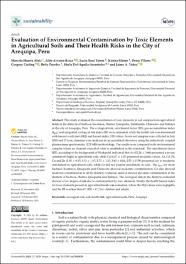Evaluation of Environmental Contamination by Toxic Elements in Agricultural Soils and Their Health Risks in the City of Arequipa, Peru

Ver/
Descargar
(application/pdf: 1.061Mb)
(application/pdf: 1.061Mb)
Fecha
2023-02-20Autor(es)
Huerta Alata, Marcela
Alvarez-Risco, Aldo
Suni Torres, Lucia
Moran, Karina
Pilares, Denis
Carling, Gregory
Paredes, Betty
Del-Aguila-Arcentale, Shyla
Yáñez, Jaime A.
Metadatos
Mostrar el registro completo del ítemResumen
This study evaluated the concentration of toxic elements in soil samples from agricultural fields in the districts of Sachaca, Socabaya, Hunter, Quequeña, Yarabamba, Characato and Tiabaya in the city of Arequipa, Peru. The ecological risk, enrichment factor (EF), geo-accumulation index (Igeo) and integrated ecological risk index (RI) were estimated, while the health risk was determined with hazard coefficient (HQ) and hazard index (HI) values. Seven soil samples were collected in July 2019 and 17 toxic elements were analyzed in an accredited laboratory using the inductively coupled plasma-mass spectrometry (ICP-MS) methodology. The results were compared with environmental samples where no element exceeded what is established in the standard. The enrichment factor (EF), according to the background of Wedepohl, indicated that As (12.26 ± 3.66) presented a severe enrichment (high) in agricultural soils, while Cd (6.87 ± 3.25) presented moderate values. As, Cd, Pb, Cu and Zn (2.85 ± 0.85; 3.53 ± 1.67; 2.71 ± 1.25; 3.83 ± 0.81; 2.55 ± 0.79) presented low to moderate enrichment in agricultural soils, while Cr did not present enrichment in soils. The Igeo for As in Sachaca, Socabaya, Quequeña and Characato showed moderate contamination, Cu also showed moderate contamination in all the districts evaluated, and Cd showed the same contamination in the districts of Sachaca, Hunter, Quequeña and Tiabaya. The ecological risk in the districts evaluated showed a low degree of risk due to contamination by toxic elements. Finally, the health hazard index for toxic elements present in agricultural soils was evaluated, where the HQ values were negligible and the HI was less than 0.1 (H1 < 0.1) for children and adults.
Colecciones
- SCOPUS [380]

